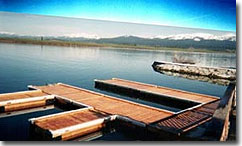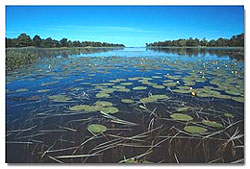Approaching The Shoreline
Approaching The Shoreline
By Richard Sims
I have done lots of shore fishing, especially in the last little while. When I'm bored at home, I always think "which is better? Watching TV or fishing?". I think the answer is obvious. Even if there's no time to get out in the boat or I'm just too tired, shore fishing is always a great alternative. But how do you approach shore areas? Obviously you're limited as to spots you can fish, so which spots should you go to and which ones should you avoid? Is it still possible to cover water from shore? Are you able to get where the fish are?? Well, maybe I can help.
 The first thing I like to do when approaching an area, is to first get a feel for what the area has to offer. I look at all the spots where I can get to the water, and decide what I can cast, if I can cast, and where to cast. I then go look around with some good polarized sunglasses (amber colored lenses allow you to see much better underwater) and see what type of structure the area has to offer. If it is a place you go to often in a boat or from shore, you can probably skip those steps because you know the area. Some places can just be avoided or fished very lightly if they have nothing to offer fish (i.e. the center of swimming beaches, shallow muddy areas, etc.). Sometimes shore spots will even give you a better casting advantage, and they will often allow you to stay quieter than in a boat.
The first thing I like to do when approaching an area, is to first get a feel for what the area has to offer. I look at all the spots where I can get to the water, and decide what I can cast, if I can cast, and where to cast. I then go look around with some good polarized sunglasses (amber colored lenses allow you to see much better underwater) and see what type of structure the area has to offer. If it is a place you go to often in a boat or from shore, you can probably skip those steps because you know the area. Some places can just be avoided or fished very lightly if they have nothing to offer fish (i.e. the center of swimming beaches, shallow muddy areas, etc.). Sometimes shore spots will even give you a better casting advantage, and they will often allow you to stay quieter than in a boat.
Now that you've found some potential hotspots, you must determine where the fish will be in them and how active they are. Quite often from shore flippin' and pitchin' are almost impossible, so you must find alternatives in order to catch fish. My favourite alternative is a 3 or 4 inch texas rigged tube jig on spinning tackle. This will allow you to cast and skip the tube long ranges to get underneath cover. But you will also need line to horse those fish out of the thick stuff. This is where 20lb. Power Pro braid comes in handy (has the diameter of 8lb mono). This is TOUGH stuff and does not ruin your guides or reel like other braids, and also casts almost exactly like mono. Some people prefer to use light tackle from shore. I don't know why this is honestly, because fish will eat exactly what they will eat if you're in a boat, but if you must, you can get downsized versions of anything. Terminator Tiny-T spinnerbaits are a good alternative to spinnerbaits. If you CAN flip from shore, don't be afraid to do so. This is how I have caught almost all of my biggest bass from shore. You still have to decide where bass will be.
Where it is legal, sinking brush or structure in otherwise empty or unproductive spots can sometimes pay off big time for shore fishing. I like to take a christmas tree or two out during winter when the ice is thick enough to walk on. I then drill holes in the trunks of the trees and tie cinderblocks to them with twine or rope. When the ice melts, SPLASH! Your trees will be in the water and ready to hold fish that season! Arranging your trees in huddled groups or pyramids tends to produce bigger bass, while single trees spread out can often produce more small ones. Remember to ask first though before putting any structure in the water, and get permits if necessary.
Another option sometimes when fishing from shore is wading. I love to wade into the water where I can, because I can walk right up and fish my spots. As long as I stay quiet, I can usually pull some nice bass out. The problem is that I can't carry all my gear with me. I just take one rod (usually a spinning reel with 20lb. Power Pro) and put the tackle I need into a backpack, so it doesn't get in the way. A trout fisherman's vest can also come in very handy, because all your lures are right their in the pockets. They're not just for trout anymore!
 I should also stress the importance of narrowing down what you bring with you when shore fishing. You can't carry 6 tackle boxes and 8 rods with you all the way down the shoreline. Well, you could, but it certainly wouldn't be very convenient. I like to take a few sample lures from each box and fit them into one or two Plano tackle trays, then just take my spinnerbait box with me, and fit it all in a backpack. This way you're prepared, but aren't full to the brim with excessive amounts of lures. A soft plastic bag is also an option if you're planning of finessing the fish. You can usually get a small enough one to fit in a backpack. I should also stress the importance of narrowing down what you bring with you when shore fishing. You can't carry 6 tackle boxes and 8 rods with you all the way down the shoreline. Well, you could, but it certainly wouldn't be very convenient. I like to take a few sample lures from each box and fit them into one or two Plano tackle trays, then just take my spinnerbait box with me, and fit it all in a backpack. This way you're prepared, but aren't full to the brim with excessive amounts of lures. A soft plastic bag is also an option if you're planning of finessing the fish. You can usually get a small enough one to fit in a backpack.
For those of you who just like to relax and catch some fish after a hard day at work (hey we've all felt like that before!), live bait is a great alternative. Now you can narrow your tackle down to a box of hooks, sinkers and floats and one ultra light or medium action spinning rod. I prefer an ultra light for this, because chances are you're going to hook into a lot of bluegill or perch in my area. In my books, you just can't beat a nightcrawler under a float. Keep your worm off bottom and fish it near structure and get ready! Sometimes even in a school of bluegill a big bass will run out and grab that worm as if his life depends on it! If you don't like worms, minnows are also a good bet. Fish them the same as nightcrawlers, or simply hook them onto a small weedless hook, weightless and let them swim around near the cover. Bass can't resist a dieing minnow! I also like crawfish sometimes when I'm looking for bigger bass. I simply hook them with a fairly small hook through the tail end, and put a 1/8 oz. or so split shot about 2 feet up the line from it. Cast it out near rocks or any other bass cover, and just let him crawl around. I find cutting off the claws makes it even more bite-worthy, as it renders the crawfish defenseless against a hungry bass. If he crawls into the rocks, just gently pull on him until he gets free. It can also help sometimes to just reel him in slowly along the bottom, as if he were swimming away from predators.
Well, I hope that this article has helped you in some way become a better shore fisherman! Always remember to stay quiet and fish areas thoroughly. You can't move around much on shore so you'll have to fish the areas you have until you're SURE there's no fish there. Look for docks, shallow weeds, laydowns or stumps to attract fish. If you find a point, all the better! Shore fishing isn't really a disadvantage! I've known people who could shore fish so well that if I were to go against them in a tournament in my boat while they fished from shore, they would whoop me a good one! Remember to stay safe out there, avoid warnings and stay off private property unless you have permission. And shore fishing is a great way to get kids fishing! Take them with you! Good luck out there, and tight lines!
|
